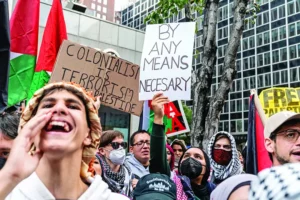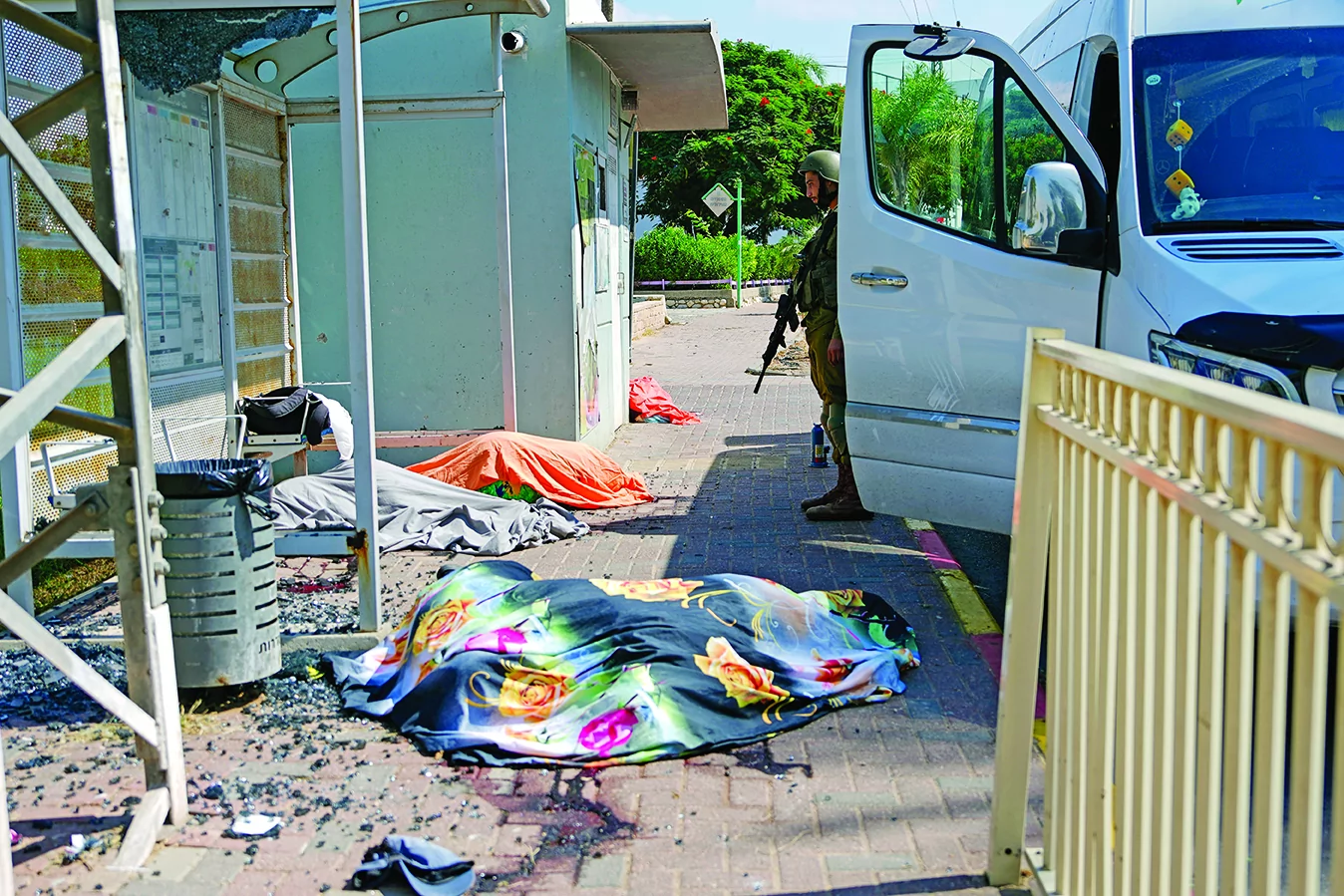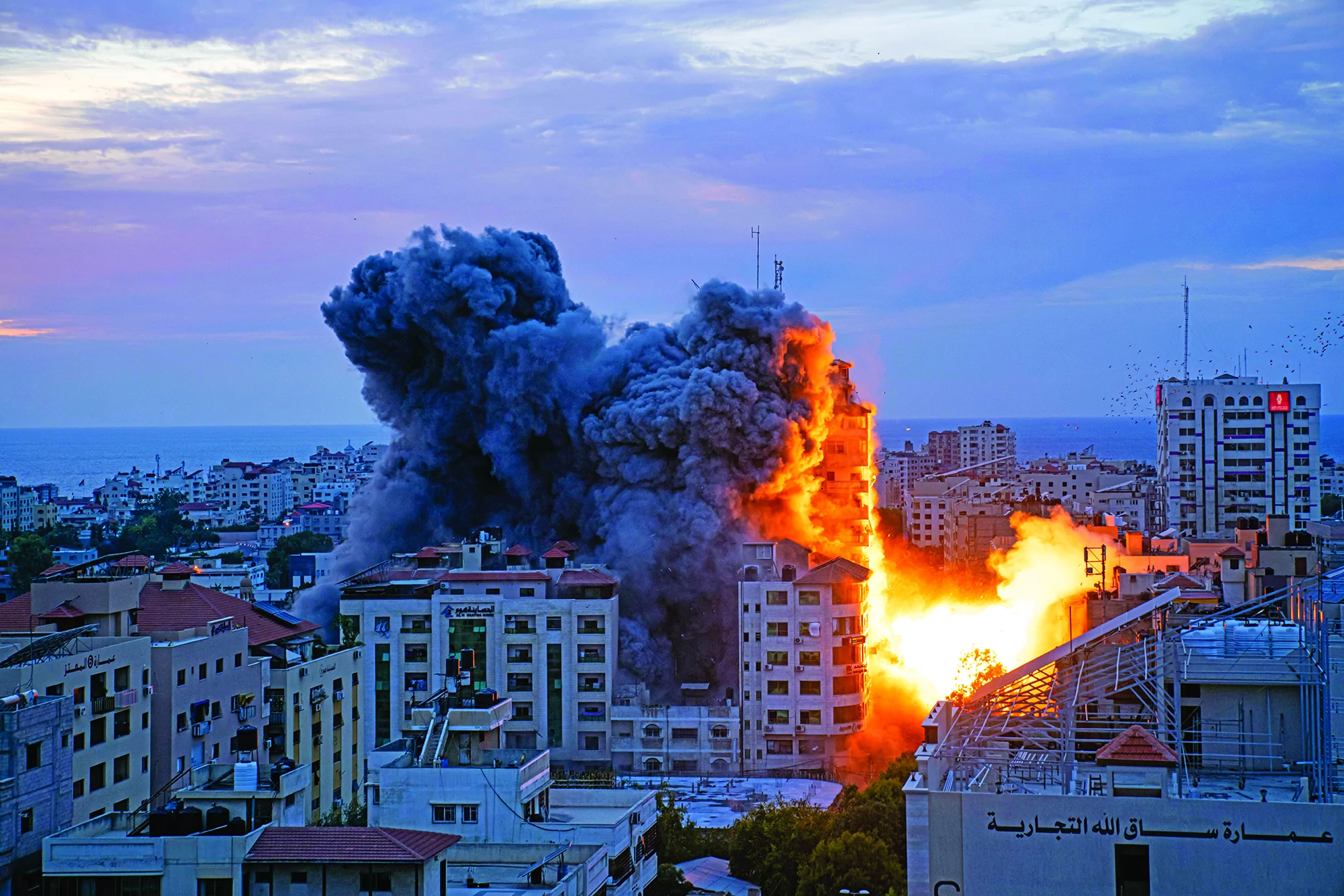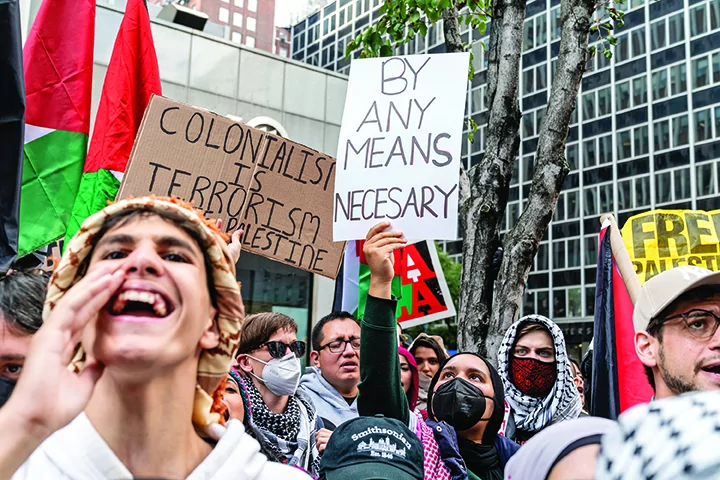
On the eve of the United Kingdom’s entry into World War I, the British Foreign Secretary Sir Edward Grey told a friend: “The lamps are going out across Europe. We shall not see them lit again in our lifetime.” Grey’s warning has become famous, presciently foretelling the near century of horrors that followed in the Great War’s wake: communism, fascism, and the rise of totalitarianism.
Similarly, the Oct. 7, 2023, invasion of Israel by Hamas and other Iranian-backed proxies is an epoch-defining moment for the Middle East and American power. The assault heralds a new Middle East, one that is even more unstable and one in which American deterrence has utterly collapsed and the Islamic Republic of Iran is surgent.

A year after the Oct. 7 attacks, the United States and its allies must have an honest reckoning with their meaning. Iran’s power has risen, while America’s has diminished.
Indeed, the breadth and scope of the invasion was astonishing. “The Hamas attack on Israel on October 7,” the journalist Seth Frantzman recently observed, “was unprecedented in its size and mass killing.” The assault was the largest invasion and organized mass killing by an Islamist terrorist group against a democracy in modern history. Adjusted for population, the massacre was roughly the equivalent of more than 30,000 Americans murdered in one day — more than 10 times the number killed by al Qaeda on 9/11.
Some 1,200 people were murdered, and around 240 others were taken hostage and brought into Gaza. An estimated 3,800 terrorists from Hamas and other Gaza terrorist groups took part, along with more than 2,000 Gaza civilians who joined in the rampage, according to the Israel Defense Forces’s Gaza Division. The border dividing Israel and Gaza was breached in 119 places. According to the IDF, 1,000 terrorists in Gaza fired rockets as part of the coordinated attack. A total of 5,000 rockets were fired at Israel in a 24-hour span — 3,000 of them in the first four hours. Terrorists used drones to disable Israeli observation posts and high-tech surveillance equipment. Terrorists on paragliders flew into the Jewish state, including the Nova music festival, where peaceful concertgoers were slaughtered and raped en masse over the course of hours. Terrorists did dry runs with motorcycles to practice taking hostages and seizing infrastructure.

The IDF would later conclude that Hamas and its minions had intended to take and hold land inside of Israel itself. Instruction manuals found on captured and killed terrorists indicate they intentionally targeted specific communities. The manuals, Israeli President Isaac Herzog noted, specified how terrorists should treat their victims: “exactly how to torture them, how to abduct them, how to kidnap them.” Those taken were to be used “as human shields” and “electric shocks” should be administered to force compliance. The German publication Bild recently reported that a document found on Hamas leader Yahya Sinwar’s computer called for using the hostages to “exert psychological pressure on the families of the prisoners, both now and during the first phase [of a ceasefire deal] so that public pressure on the enemy government increases.”
Some reports indicate that Hamas began planning the operation as early as 2014. It couldn’t have done so without Tehran’s support. According to the Wall Street Journal, 500 operatives from Hamas and the Palestinian Islamic Jihad “received specialized combat training in Iran” in the weeks leading up to the assault. Iran’s Islamic Revolutionary Guard Corps Quds Force conducted the training with top Iranian and Palestinian leaders in attendance. The IRGC, which has trained and equipped other terrorist groups, including Hezbollah and al Qaeda offshoots, was designated as a foreign terrorist organization by then-President Donald Trump in 2019.

In the days and months leading up to the assault, Hamas conducted a sophisticated disinformation campaign meant to deceive Israeli officials into thinking Gaza was quiet and that should an attack occur, it would likely come from Hezbollah on Israel’s northern border. Regrettably, this lie was swallowed, hook, line, and sinker. For years, the Israeli security establishment bought the idea, an idea pushed by many, including the Qataris and some in the U.S. State Department, that it could buy peace from Hamas with copious amounts of aid. Oct. 7 revealed this to be an illusion. As foreign affairs analysts Shoshana and Stephen Bryen observed a few days after the massacre, the Hamas-led invasion showed that “terrorist groups can’t be managed.” An offshoot of the Muslim Brotherhood that has operated in the area since the 1930s, Hamas was created in the 1980s and began receiving extensive support from Iran in 1989. Like its paymasters in Tehran, Hamas explicitly calls for Israel’s destruction and the genocide of its Jews. Put simply: It is the closest modern-day ideological heir to Nazi Germany. History is clear: There can be no negotiating with genocidal entities. It will not moderate its “final solution.”
Oct. 7 illustrated that Hamas and Iran mean what they say — their rhetoric is not, as some press and policymakers would have it, meant purely for domestic consumption. The Hamas Covenant of 1988, the group’s foundational document, says that “there is no solution to the Palestinian question except through Jihad” and “initiatives, proposals and international conferences are a waste of time and vain endeavors.” Hamas must be taken at its word. This must be the chief lesson from that grim day.
The Oct. 7 massacre was the largest slaughter of Jewish civilians since the Holocaust — an ill-omen for the non-Jewish world, as well. It is often said that the Jewish people are a “canary in the coal mine.” Throughout history, time and again, escalating violence against Jews has presaged something larger, something darker for the rest of the world. “Wherever antisemitism took hold,” the late historian Paul Johnson once observed, “social and political decline almost inevitably followed.”

Indeed, the last time that Jews were massacred in the numbers seen last fall, the world itself was at war in the most destructive conflict that the Western world has ever seen. The Jewish people, Winston Churchill remarked in November 1941, “bore the brunt of the Nazis’ first onslaught upon the citadels of freedom and human dignity.” Much of the globe was apathetic to the persecution of European Jewry in the 1930s — a persecution that presaged the barbarism yet to come. Regrettably, Oct. 7 illustrated that many continue to be apathetic when totalitarian movements seek to perpetrate another genocide of Jewry. The Nazis had their apologists, and so does Hamas. But that much of the “international community” was once again OK with, or even complicit in, another mass murder of Jews doesn’t bode well for the fate of the civilized world. The skyrocketing antisemitism in the West, including at many universities where students and faculty openly celebrated the attacks, is ominous. Clouds are gathering.
Iran has largely managed to evade responsibility for its role. In many respects, Oct. 7 was the Iranian regime announcing that it would no longer be restrained, no longer encumbered, in its chief objective: mastery of the Middle East. At its core, Iran is an imperialist power that seeks to dominate the region and spread its perverse ideology. Antisemitism is a key component, yes, but the regime’s ambitions go beyond re-creating the Holocaust. As the historian Ray Takeyh has noted, the mullahs see themselves as launching a new “Islamic epoch” with themselves at the epicenter. Regime founder Ayatollah Ruhollah Khomeini called for a “revolution without borders,” exhorting: “We don’t recognize Iran as ours, as all Muslim countries are part of us.” This has been Iran’s animating feature since its founding in 1979. But in many respects, Oct. 7 was its coming-out party.
Iran’s goals are clear enough for those willing to listen to the regime’s words. But Tehran has a strategy, as well. The regime seeks to envelop Israel in a “Ring of Fire,” using its proxies to surround the Jewish state on all sides and then overwhelm it in a war of attrition that will wear down its missile defense systems, military personnel, and public. The Committee for Accuracy in Middle East Reporting and Analysis first warned about this strategy in a March 2018 Washington Examiner op-ed titled “Israel may be facing a five-front war.” Indeed, Tehran has spent the last two decades building up its capabilities in the region: from Hezbollah in Lebanon on Israel’s northern border to the Houthis in the Red Sea and Iranian proxies in Iraq and Syria. Iran has been making inroads in the so-called West Bank (Judea and Samaria), which is nominally ruled by the Palestinian Authority. Iranian proxies have even been found operating in Israel itself and running weapons to Israeli Arab communities while seeking to incite internecine violence. More recently, the regime has been increasing its operations to topple the Hashemite monarchy in Jordan, no doubt hoping to open yet another front in its war against Israel. In some respects, Oct. 7 and the subsequent attacks by other Iranian proxies should be viewed as a “dry run.” Iran is testing Israel, probing for soft points.
By destroying the Jewish state, Iran will have accomplished a feat that eluded ruling Arab monarchies of the 1940s, Arab nationalists in the ’50s, ’60s, and ’70s, and generations of terrorists from Yasser Arafat and the Palestine Liberation Organization to al Qaeda and the Islamic State. Tehran will then be the unquestioned dominant power of the Islamist world and will usher in a new age. This, clearly enough, is its ambition. Oct. 7 showed that the Iranian regime has more than the motive. It increasingly believes it has the means, as well.
For years, Iran has used its proxies to wage war. Iran, while comparatively lacking conventional military capabilities, has relied on asymmetrical warfare. Iran’s support for terrorist groups has provided the regime with plausible deniability, enabling it to mask its hand for a West that is often too willing to look the other way. But after Oct. 7, the mask is off.
In mid-May, Iran launched a barrage of hundreds of rockets, missiles, and drones at the Jewish state. Tehran’s assault marked a significant escalation. Previously, the regime used its proxies to carry out such attacks. However, this was the first time that Iran chose to launch an attack of this scale directly from its soil. Clearly, Iran no longer feels the need to keep up pretenses. If Oct. 7 didn’t show that Iran is emboldened, the attack in mid-May, coinciding with attacks on both Israel and U.S. forces in the region, shows that the regime remains undeterred.
If Iran’s calculus has changed, it stands to reason that Israel’s should, too. The Jewish state has experienced the largest loss of civilian life since its founding. The barbarians are no longer at the gates — they’ve broken through, into Israeli homes, proudly filming the horrors that they inflicted on children, families, and the elderly. Israel’s subsequent incursion into Gaza, and its largely successful military campaign against Hamas, illustrates that, at some level, the Jewish state knows that the previous policy of “managing terrorists” will no longer suffice. But problems abound.
Hezbollah, a far more dangerous foe than Hamas, sits to Israel’s north, with more armaments and precision-guided missiles than most European nations. And like Hamas, Hezbollah uses human shields, hiding its weapons and operatives in densely populated civilian communities, hospitals, and schools. A war with Hezbollah would be of a type unseen in the Middle East for generations. Israel has made it clear that in the event of a broader conflict, the head of the snake wouldn’t go untouched. Yet Jerusalem might not be able to wait.
Oct. 7 likely changed Israeli thinking regarding Iran’s nuclear weapons program. While most Israelis, like most Americans, oppose Iran acquiring nuclear weapons, some have argued that Iran can be discouraged from using nukes should it acquire them. After Oct. 7, such optimism is a luxury that Israel can no longer afford.
Iran remains steadfast in its ambition to become a nuclear state. Organizations such as the Foundation for Defense of Democracies and the Institute for Science and International Security have chronicled the gains that Iran has been making in this regard. Tehran has refused to cooperate with the International Atomic Energy Association and is stockpiling enriched uranium while installing hundreds of new centrifuges. Citing a recently published U.S. intelligence report that indicates the regime has “undertaken activities that better position it to produce a nuclear device,” FDD’s Andrea Stricker warned that “as Iran inches across the nuclear threshold, America is wasting precious time.” Israel may have to act to prevent the world’s leading state sponsor of terrorism from going nuclear.
Oct. 7 showed Israel the consequences of being reactive and indulging in wishful thinking. But it also illustrated that the press and the so-called international community will likely condemn Israel no matter what steps the Jewish state takes to protect itself and prevent another massacre. Many Western media outlets have parroted Hamas-supplied casualty figures, effectively doing the terrorist group’s PR. The United Nations, too, has been feckless. If Israel rightly feels that it can’t get a fair shake, let alone redress, it is only further incentivized to take the steps it feels compelled to take. And why not? Bad headlines from biased newspapers are a small price to pay to avoid another Oct. 7.
Another factor makes both escalation and a broader war more likely: the United States. The war launched by Iranian proxies against Israel is as much the result of Iranian ambitions as American foolishness. U.S. deterrence has utterly collapsed, and the U.S. only has itself to blame. U.S. withdrawal from the region isn’t so much the problem as the way that withdrawal has been carried out. Instead of thwarting Iranian ambitions, too often Washington has placated and enabled them. Tehran has received sanctions relief and the delisting of its terrorist proxies, such as the Houthis, in exchange for ceding nothing of consequence and uttering transparently false promises. During the war against ISIS, the U.S. even effectively acted as air support for Iranian militias. The U.S. continues to give aid and arms to the Lebanese Armed Forces, under whose auspices Hezbollah has grown. America could have withdrawn from the Middle East and propped up key regional pillars such as Israel and Saudi Arabia. Instead, too often, it has chosen to undermine them while accommodating Iran, a sworn enemy. Such impudence seldom goes unpunished, and American power has taken a hit post-Oct. 7.
An attack on a key American ally, arguably the key American ally in the region, has not gone unnoticed by others, both in the region and far from its shores. After Oct. 7, the security guarantee offered, implicitly and otherwise, by being friends with the U.S. isn’t what it once was. In a regional contest for influence between the U.S. and its foremost opponent, China, more nations are likely to hedge their bets. Hamas may be losing, but Iran, Beijing’s chief foil, is on the march.
CLICK HERE TO READ MORE FROM THE WASHINGTON EXAMINER
“Great battles, won or lost, change the entire course of events,” Churchill once intoned. They “create new standards of values, new moods, new atmospheres, in armies and in nations, to which all must conform.” Oct. 7 can’t be accurately described as a “battle,” although many defenders fought bravely and pushed Hamas-led invaders back. Rather, it was a massacre of innocents. But it seems certain that the entire course of events has changed.
An honest observer is left with one conclusion: More war awaits.
Sean Durns is a senior research analyst for CAMERA, the 65,000-member, Boston-based Committee for Accuracy in Middle East Reporting and Analysis.






